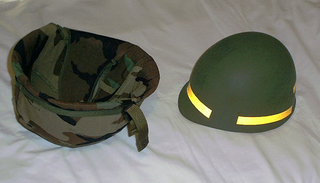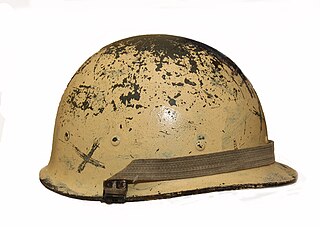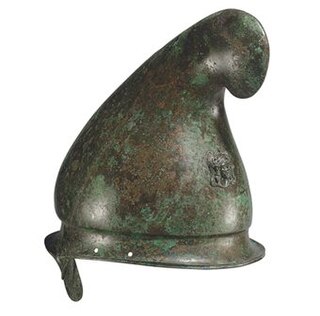
A helmet is a form of protective gear worn to protect the head. More specifically, a helmet complements the skull in protecting the human brain. Ceremonial or symbolic helmets without protective function are sometimes worn. Soldiers wear helmets, often made from lightweight plastic materials.

A hard hat is a type of helmet predominantly used in workplace environments such as industrial or construction sites to protect the head from injury due to falling objects, impact with other objects, debris, rain, and electric shock. Suspension bands inside the helmet spread the helmet's weight and the force of any impact over the top of the head. A suspension also provides space of approximately 30 mm between the helmet's shell and the wearer's head, so that if an object strikes the shell, the impact is less likely to be transmitted directly to the skull. Some helmet shells have a mid-line reinforcement ridge to improve impact resistance. The rock climbing helmet fulfills a very similar role in a different context and has a very similar design.

The Brodie helmet is a steel combat helmet designed and patented in London in 1915 by John Leopold Brodie. In modified form it became the Helmet, steel, Mark I in Britain and the M1917 Helmet in the U.S. Colloquially, it was called the shrapnel helmet, battle bowler, Tommy helmet, tin hat, and in the United States the doughboy helmet. It was also known as the dishpan hat, tin pan hat, washbasin, battle bowler, and Kelly helmet. The German Army called it the Salatschüssel. The term Brodie is often mis-used. It is correctly applied only to the original 1915 Brodie's Steel Helmet, War Office Pattern.

The M1 helmet is a combat helmet that was used by the United States military from World War II until 1985, when it was succeeded by the PASGT helmet. For over forty years, the M1 was standard issue for the U.S. military. The M1 helmet has become an icon of the American military, with its design inspiring other militaries around the world.
The Kabutowari , also known as hachiwari, was a type of knife-shaped weapon, resembling a jitte in many respects. This weapon was carried as a side-arm by the samurai class of feudal Japan.

The lobster-tailed pot helmet, also known as the zischägge, horseman's pot and harquebusier's pot, was a type of post-Renaissance combat helmet. It became popular in Europe, especially for cavalry and officers, from c. 1600; it was derived from an Ottoman Turkish helmet type. The helmet gradually fell out of use in most of Europe in the late 17th century; however, the Austrian heavy cavalry retained it for some campaigns as late as the 1780s.

The Montefortino helmet was a type of Celtic, and later Roman, military helmet used from around 300 BC through the 1st century AD with continuing modifications. This helmet type is named after the region of Montefortino in Italy, where a Montefortino helmet was first uncovered in a Celtic burial.

The Coolus helmet was a type of ancient Celtic and Roman helmet. It was typically made in bronze or brass and, like the Montefortino type with which it co-existed, was a descendent of Celtic helmet types. The Canterbury helmet from England is an example.
The Imperial helmet-type was a type of helmet worn by Roman legionaries. Prior to the Empire, Roman Republican soldiers often provided their own equipment, which was passed down from father to son. Thus a variety of equipment, from different eras was present in the ranks. Even as the professional Imperial Army emerged, and short-term service citizen soldiers became rare, useful equipment was never discarded. So when the improved Imperial helmet appeared, it replaced what remained of the very old Coolus type, which was largely superseded at the time by improved versions of the Montefortino helmet type which continued to serve alongside it for a time. This constituted the final evolutionary stage of the legionary helmet (galea).

The pileus was a brimless, felt cap worn in Illyria and surrounding regions, later also introduced in Ancient Rome. The Greek πιλίδιον (pilidion) and Latin pilleolus were smaller versions, similar to a skullcap.
The Bulgarian M36 helmet was the basic helmet of the Bulgarian Army prior to the outbreak of World War II and during the Bulgarian participation in the war. Its latest variant is still in service along with several different modern helmets, but is being phased out in favor of more modern kevlar helmets.

The Boeotian helmet was a type of military helmet used in Ancient Greece during the classical and Hellenistic periods, as well as in Ancient Rome; it possibly originated in the Greek region of Boeotia.

The Iraqi M80 Helmet is a military helmet made of compressed canvas used by the Iraqi Armed Forces from the early 1980s onwards. They were used in the Iran–Iraq War, the Persian Gulf War/Operation Desert Storm, and the 2003 Invasion of Iraq/Operation Iraqi Freedom. These helmets were originally manufactured and designed in South Korea but in 1990 an Iraqi-made version appeared, which is usually fitted with a distinctive rubber rim. Both types of helmet are still in limited service with the Iraqi Security Forces but are being replaced by the American PASGT helmet.

The Phrygian helmet, also known as the Thracian helmet, was a type of helmet that originated in Classical Greece and was widely used in Thrace, Dacia, Magna Graecia and the Hellenistic world until well into the Roman Empire.

The Late Roman ridge helmet was a type of combat helmet of Late Antiquity used by soldiers of the Late Roman army. It was characterized by the possession of a bowl made up of two or four parts, united by a longitudinal ridge.

The Nijmegen Helmet is a Roman cavalry sports helmet from the first or second century AD. It was found around 1915 in a gravel bed on the left bank of the Waal river, near the Dutch city of Nijmegen. The helmet would have been worn by the élite Roman cavalry. The head portion of the helmet is made of iron, while the mask and diadem are of bronze or brass. The helmet has a neck-protecting projecting rim, overlaid with a thin bronze covering plated with silver. The diadem features two male and three female figures.

A racing helmet is a form of protective headgear worn by racing car and rally drivers. Motor racing has long been known to be an exceptionally risky sport: sudden deceleration forces on the head can easily occur if a racing car loses control at the very high speeds of competitive motor racing or the rough terrain experienced in rallying. A risk more nearly unique to motor racing is the possibility of drastically severe burns from fuel igniting when the fuel lines or fuel tank of the vehicle are jolted sufficiently to dislodge or breach them in a situation in which the driver cannot soon enough escape from his car. This happened to world champion driver Niki Lauda at the 1976 German Grand Prix race at the Nürburgring in a crash from which he barely escaped alive.

GK80 is a Chinese steel combat helmet first developed in the late 1960s. Developed as part of a Chinese military aid to Albania in response to the Sino-Soviet split, the helmet was initially designated as the "Type 69" and was only issued in small numbers within the People's Liberation Army. An improved design was re-designated as the GK80 and was adopted as the standard combat helmet of the PLA in 1980. The move was part of a PLA modernization program immediately after encountering drawbacks in the Sino-Vietnamese War in 1979, which the PLA realized the necessity to modernize its arsenal.

The Emesa helmet is a Roman cavalry helmet from the early first century AD. It consists of an iron head piece and face mask, the latter of which is covered in a sheet of silver and presents the individualised portrait of a face, likely its owner. Decorations, some of which are gilded, adorn the head piece. Confiscated by Syrian police soon after looters discovered it amidst a complex of tombs in the modern-day city of Homs in 1936, the helmet was eventually thoroughly restored at the British Museum, and is now in the collection of the National Museum of Damascus. It has been exhibited internationally, although as of 2017, due to the Syrian Civil War, the more valuable items owned by the National Museum are hidden in underground storage.

















